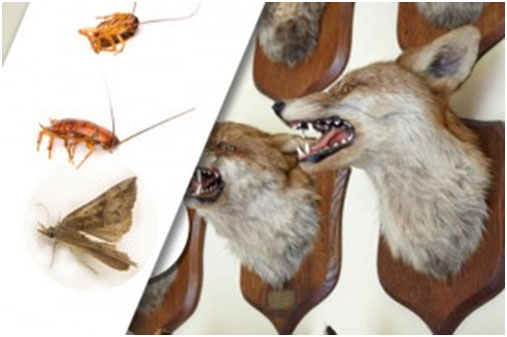Dangers of Insect Infestation in Taxidermy
Even though a preserved hide has had all of the muscle removed from it, been treated, dried, glued, and mounted, that doesn’t mean that something won’t still try to eat it. Moths, dermestid beetles, and cockroaches commonly infest mounted trophies for various reasons, and can ruin even the best taxidermy mount.

Dangers of insect infestation in taxidermy
Moths and certain types of beetles can infest woolen clothing in closets, because their larvae enjoy eating the keratinized proteins in hair shafts. Once a hide is mounted, the hair and fur of that animal become a potential moth buffet. While adult moths and beetles aren’t really an issue, the sight of them is probably the first clue that an infestation has occurred. After the larvae get their teeth into mounted animal, bald patches, tracks, and broken hairs will start to become noticeable.
Unfortunately, unlike dust or fading, there really isn’t a way to fix that. Methods of handling moth or beetle larvae include temporarily freezing mounts, fumigating rooms, or using special sprays or other chemicals to treat trophies. However, these will only get rid of the larvae; they can’t restore the look of your trophies. Cedar chips, mothballs, and Epsom salts can be used as preventatives, but all have their own limitations.
Though usually associated with cleaning skulls and bones for mounting, dermestid beetles are opportunistic feeders that will move on whatever’s next once the meat is gone. This can include wool clothing, fur coats, or mounted trophies. Signs of an infestation include shed beetle shells, crawling larvae, and signs of damage on mounted trophies. Because dermestid eggs are extremely durable, getting rid of an infestation can be a problem. Boric acid is useful for dehydrating beetle eggs and larvae and causing them to die; while frequent vacuuming can help get rid of larvae, beetles, and eggs. Preventing dermestid beetle infestations mostly consists of keeping a close eye out for the kinds of things they like to eat, and removing any adult beetles before they have a chance to lay eggs.
Cockroaches are opportunistic feeders that will eat fur, glue, and everything in between. Unfortunately, seeing them on or near your trophies (particularly in the light) generally indicates a wide-spread infestation, and the only solution might be to seek professional help. Many roach sprays will damage trophies, so removing bugs manually, sprinkling boric acid around the areas roaches frequent, and fumigating the house as a whole, might be the only viable alternative. Preventing roaches mostly consists of keeping the house clean, fixing water leaks, and keeping any food items in secure, airtight packaging.
Unfortunately, once a mounted trophy has been damaged by infestation, all that can often be done is to prevent further damage. By keeping your home and the room your trophies are kept in clean and inhospitable to bugs, however, you can help keep your trophies in flawless, undamaged condition.


Share Your Thoughts!